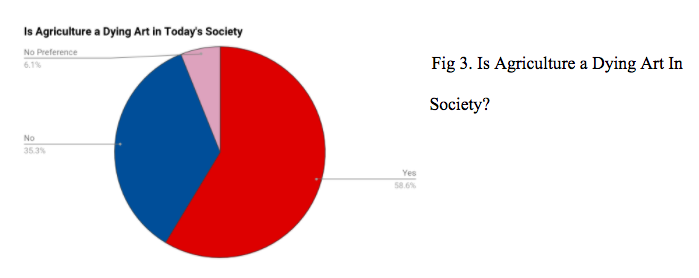A Dying Art
*This is the second in our series featuring senior thesis projects
From toothpaste you squeeze on your brush to the fuel you pump into your car, agriculture affects every aspect of our lives, and without it out the way we live our lives would be drastically different. The recent decline in America’s agriculture is affecting America’s economy as a whole, agriculture makes up 90 percent of the nation’s everyday lives from what people eat, what people wear, and even how people live in general.
With the declining agriculture in America the American economy could be at risk of declining with it if the public doesn’t address the issues at hand. America’s farmers and ranchers make an important contribution to the U.S. economy by ensuring a safe and reliable food supply, improving energy security and supporting job growth and economic development. As Klobuchar, a democratic presidential candidate, analyzes, “The United States has a robust farm economy… The total farm cash receipts (in 2012) exceeded $390 billion, including $219.6 billion in cash receipts for crops and $171.7 billion in cash receipts for livestock and related products” (Klobuchar 1). American agriculture is one of the most efficient and productive systems in the world even though it only holds two percent of the working industries population. This efficiency gives the United States the ability to be one of the world’s largest exporters of foods and materials, sending agricultural products around the world.
Throughout the population’s everyday lives people are constantly using materials and products that all relate back to agriculture, but most of these products do not support American agriculture and companies, but instead the rest of the world. In order for a product to be labeled as “made in America” only 50% of the product has to be from the USA itself. This means that half of the revenue from the product is given to countries all around the world, decreasing America’s economic growth. If the United States claims to be the economic powerhouse it is, then why do we let other countries take our money instead of constantly putting the money back into the United States economy. David ,from the University of Zurich, found in a study that from “2001 to 2008,” the domestic outsourcing began to accelerate again,” repeating what had happened after the Great Recession (Dorn 5). If all those jobs returned, it would be enough to also hire the 4.3 million who are working part-time but would prefer full-time positions.” The decline of America’s personal agriculture sector brings unemployment, economic decline, and a reliance on other countries, so why would the government not advertise and endorse more jobs in the agricultural field to solve these issues?
The agricultural field offers thousands of jobs, but because most of these jobs our outsourced which decreases the amount available to America’s public. The percentage of the United States that is engaged in the labor force in agriculture “fell from 41 percent in 1900 to 21.5 percent in 1930,” it continued to decrease to “4 percent in 1970,” and to “1.9 percent in 2000” (Gross). The decline of agricultural employment has continued to fluctuate. In 1920 the amount of agricultural jobs in America “peaked at about 12 million,” the total number of jobs fell “about two-thirds of the total over several decades” (Gross). Daniel Gross’s area of expertise is in strategies of business. He writes a lot about supply and demand along with business basics. The statistical values he writes about shows how agricultural jobs have decreased per year. It used to employ a very large proportion of the workforce and provided wages to people without advanced education. The United States Department of Agriculture noted that “in 2017, 21.6 million full- and part-time jobs were related to the agricultural and food sectors” (Ag and Food Sectors and the Economy). The United States Department of Agriculture researches the jobs in the country that are related to the agriculture or food sector of the economy. With such a large portion of the workforce being filled by agricultural related jobs the demand for these positions are always high, and range from no college experience to masters and doctorates in agricultural studies. These millions of job positions available in the agricultural field are always in demand, but instead of hiring American citizens to support the economy, most of these positions are filled by outsourcing jobs to other countries.
When America first became its own nation, the basis of its whole economy was dependent on the farming lifestyles of all citizens, but as time has progressed the country has relied more and more on other countries to support itself. “The number of farms declined by 3.25 million since 1950, with the largest decrease-1.7 million-occurring between 1950 and 1960,” Daly points out (Daly). In 1960, the number of agricultural jobs in America had “a drop of 1 million,” this decline was followed by “0.5 million more in the 1970’s” (Daly). As the number of farms decreased, their average size increased. This, combined with several economic and sociological factors resulted in a different societal makeup of classes, Generally describing the workers in wage categories: self employed, and unpaid family workers-in the industry. The Monthly Labor Review gives the statistics of the decline of farms in America since the 1950s. The fewer farms per decade shows that as time has progressed the importance of agriculture has slipped the minds of the public and has also been less prioritized by the government. The “U.S. farm output grew by 170 percent between 1948 and 2015—at an average annual rate of 1.48 percent,” Wang states. The total input rose to only seven percent over the same period. The “productivity growth accounted for most of total output growth during that period. TFP grew at an average annual rate of 1.38 percent, compared to 0.1 percent for total inputs” (Wang, Agriculture Productivity). On the contrary, the fact that farms are declining the US farm output has continued to increase. The new technologies created allow fewer farms to be able to produce more products for a larger population.With the decline of the amount of farms that cover the U.S. the production of each farm continues to improve each year.
With particular job skills being a large focus of schools now, particular job fields are more endorsed than others such as business, medical, and liberal arts, but there is never a huge focus on agricultural fields of study. The agricultural industry has changed drastically. A main component to the change in agriculture is technology, it has impacted the agricultural sector “by eliminating many jobs but also creating new opportunities” (Mosheim). As Mosheim states, “the industry needs to find ways to show people that there are rewarding career opportunities in agriculture” (Mosheim). Another main issue that agriculture faces is the issue of recruitment. This section of the workforce is one which affects all sectors of the economy. Recent demographic studies show that the average age of all workers is continuing to increase, this study includes the profession of farming. The average age increase means that there are fewer workers to go around and all economic sectors will be challenged by the labor force. Schools and organizations are trying to focus more recruitment on younger generations to increase the agricultural workforce. “The University of Idaho found that 60 percent of incoming college agricultural students had been heavily involved in 4-H, and 50 percent had been in high school vocational agricultural programs” (Wang, Agriculture Productivity). The importance of youth development through these agriculture focused organizations should be recognized by those who hope to attract participants into the agricultural sector. “More direct initiatives aimed at attracting youth to such programs would have promising results for colleges and employers. Declining involvement in such organizations directly yields a decline in the potential pool of career agricultural workers” (Wang, Agriculture Productivity). The University of Idaho found that most students coming into their college were involved in an agricultural organization in high school. These students were also more likely to pick studies in agriculture.In order for America’s agricultural sector to continue to grow the agricultural field and organizations should be largely publicized to get young people involved and interested in the agricultural sector of the U.S. The world of Agriculture has continued to decrease yearly. It seems to attract less and less young adults to join its workforce. With how much agriculture surrounds us why does it seem to lack importance in the minds of the U.S.? From the outsourcing of jobs to the continued agricultural decline that affects the overall economy of America what could the government do to help agriculture become a main focus again?
A study was conducted to determine high school students’ opinions about the agricultural workforce and how it is presented to their generation. A total of thirty-one high school students, ranging from multiple schools across the United States, took part in the survey. Students self-selected to participate in the study which was posted to various social media platforms. Students responded to opinion based questions such as what they thought was included in the agricultural workforce, if they are interested in an agricultural job and if they grew up around someone involved in the agricultural workforce. Next, they were asked to clarify if they were enrolled in any agricultural classes in school and if they were a part of any extra-curricular agricultural programs. They were also asked to rank how they feel agricultural affects the economy and how well agriculture is advertised today on a scale of one to five. They were also asked if they were ever advertised any agricultural job, who they think advertises them, and what they think the government does to affect those numbers of the labor force. Lastly they were asked if they think agriculture is a dying art today and what the solution to the decreasing numbers in the agricultural labor force would be.

From the survey, taken by high school students, both Fig 1. and Fig 2 were created. When students were asked what they thought the importance of agriculture was to America’s economy one student answered “moderately important,” nine students answered “kinda important,” and twenty-one students answered “very important.” This shows that out of a sample of thirty-one students ninety-six percent of them said that agriculture is important to the economy. When asked if they thought agricultural jobs were advertised to their generation, high school students answered how much they thought it was advertised and their answers are shown in Fig 2. Five students answered “none,” thirteen students answered “not very,” eleven students answered “moderately,” and two students answered “often.” This shows that fifty-eight percent of the sample stated that they don’t think agriculture is advertised. When comparing Fig 1. and Fig 2. it can be seen that even though ninety-six percent of high schoolers think agriculture is important to the economy, more than half of the students stated that they don’t think the agricultural workforce is advertised to their generation.
 When asked if they thought agriculture was a dying art in today’s society students answered “yes, no, and no preference,” which is shown in Fig 3. Fifty-eight percent of the students answered “yes,” thirty-five students answered “no,” and six percent had no answer. One student stated that they believe that they thought that the reason that the agricultural workforce is declining is because “it is not encouraged, the current tariffs are making small family operations hard to run.” Another student stated that the lack of “open land” poses an issue for the agricultural workforce which could be a reason that the workforce is declining. Lastly, a student explained that “the increase of technological jobs and farmers selling their land to housing developers” is causing the agricultural workforce to continue to decline.
When asked if they thought agriculture was a dying art in today’s society students answered “yes, no, and no preference,” which is shown in Fig 3. Fifty-eight percent of the students answered “yes,” thirty-five students answered “no,” and six percent had no answer. One student stated that they believe that they thought that the reason that the agricultural workforce is declining is because “it is not encouraged, the current tariffs are making small family operations hard to run.” Another student stated that the lack of “open land” poses an issue for the agricultural workforce which could be a reason that the workforce is declining. Lastly, a student explained that “the increase of technological jobs and farmers selling their land to housing developers” is causing the agricultural workforce to continue to decline.
This paper sought to determine whether the agricultural workforce in America is in danger of being a dying way of life in the future. These results suggest that high school students believe that the agricultural workforce is important to our economy but yet it is not advertised to the younger generations. These findings build on the existing evidence that there is a continuing decline of agriculture in America (Daly: Gross, 2016). The productivity rates of agriculture do continue to rise because of the new technologies available (Wang). As the productivity continues to increase the agricultural workforce continues to decrease. The way of life starts to dwindle, leaving the work up to machines and a few workers to provide for the world’s population.
This paper demonstrates that the agricultural workforce is continuing to decline and that there is not much effort being done right now to solve the issue. The United States government should look at what the effects of the decrease in the workforce would be if it continues. There is not much research done at the moment on what the future holds for agriculture so further studies would need to be done before drawing any conclusions about the pros or cons about the workforce today. More research would need to be done before concluding anything about the younger generations and their correlation with the agricultural workforce.
Works Cited
Daly, Patricia A. “Agricultural Employment: Has the Decline Ended?” Bureau of Labor Statistics, 0AD, www.bls.gov/opub/mlr/1981/11/art2full.pdf.
Dorn, David, et al. “Domestic Outsourcing in TheUnited States .” Dol.gov, 31 Jan. 2018, www.dol.gov/sites/dolgov/files/OASP/legacy/files/Domestic-Outsourcing-in-the-United-States.pdf.
Gross, Daniel. “U.S. Farms Still Feed the World, but Farm Jobs Dwindle.” Strategy+Business, 2 Aug. 2016, www.strategy-business.com/blog/US-Farms-Still-Feed-the-World-But-Farm-Jobs-Dwindle?gko=8741c.
Klochbuchar, Amy. “The Economic Contribution of Americas Farmers and the Importance of Agricultural Exports.” Joint Economic Committee, United States Congress, Sept. 2013, www.jec.senate.gov/public/_cache/files/266a0bf3-5142-4545-b806-ef9fd78b9c2f/jec-agriculture-report.pdf.
Morrison, Rosanna M. “Ag and Food Sectors and the Economy.” USDA ERS – Ag and Food Sectors and the Economy, 2019, www.ers.usda.gov/data-products/ag-and-food-statistics-charting-the-essentials/ag-and-food-sectors-and-the-economy/.
N.A. “American Agriculture Facts.” AgHires, 7 Mar. 2019.








